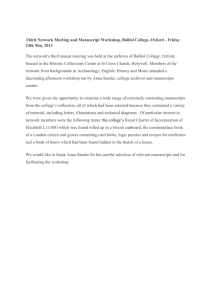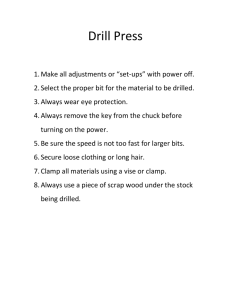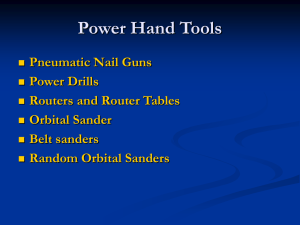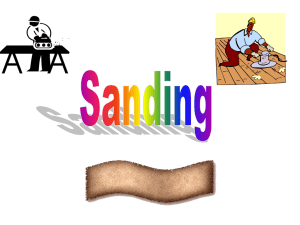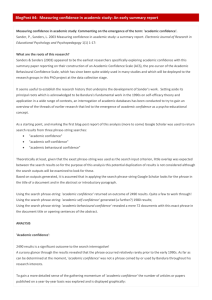Lesson Plan : Powerpoint Presentations
advertisement
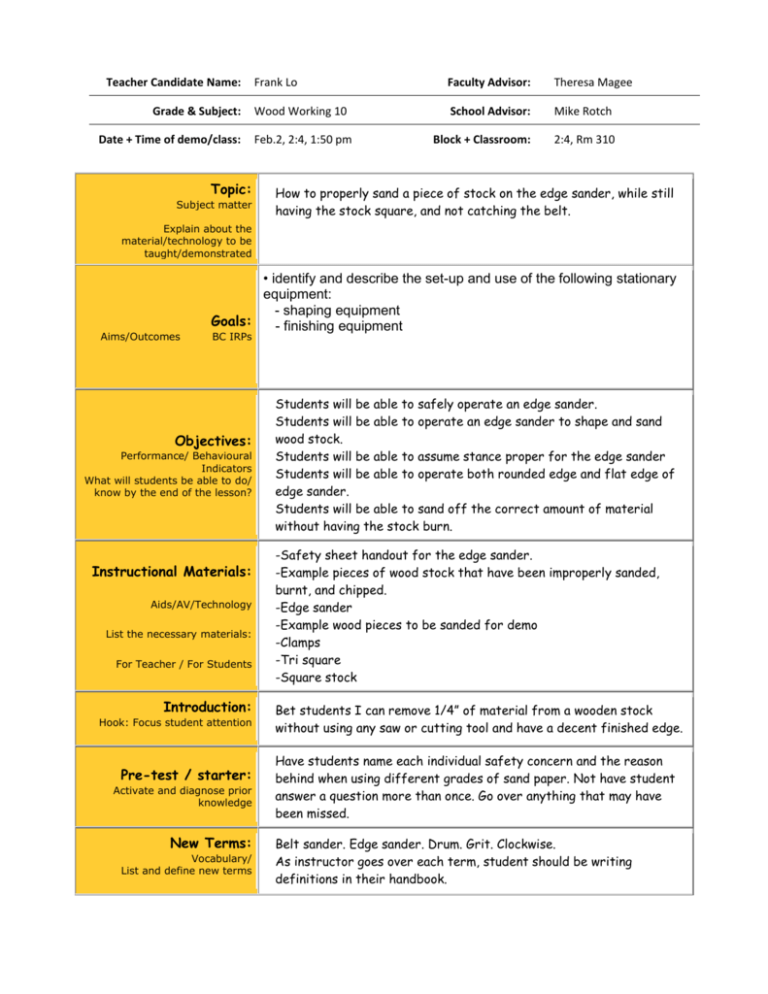
Teacher Candidate Name: Grade & Subject: Date + Time of demo/class: Topic: Subject matter Frank Lo Faculty Advisor: Theresa Magee Wood Working 10 School Advisor: Mike Rotch Block + Classroom: 2:4, Rm 310 Feb.2, 2:4, 1:50 pm How to properly sand a piece of stock on the edge sander, while still having the stock square, and not catching the belt. Explain about the material/technology to be taught/demonstrated Aims/Outcomes • identify and describe the set-up and use of the following stationary equipment: - shaping equipment Goals: - finishing equipment BC IRPs Objectives: Performance/ Behavioural Indicators What will students be able to do/ know by the end of the lesson? Instructional Materials: Aids/AV/Technology List the necessary materials: For Teacher / For Students Introduction: Hook: Focus student attention Pre-test / starter: Activate and diagnose prior knowledge New Terms: Vocabulary/ List and define new terms Students will be able to safely operate an edge sander. Students will be able to operate an edge sander to shape and sand wood stock. Students will be able to assume stance proper for the edge sander Students will be able to operate both rounded edge and flat edge of edge sander. Students will be able to sand off the correct amount of material without having the stock burn. -Safety sheet handout for the edge sander. -Example pieces of wood stock that have been improperly sanded, burnt, and chipped. -Edge sander -Example wood pieces to be sanded for demo -Clamps -Tri square -Square stock Bet students I can remove 1/4” of material from a wooden stock without using any saw or cutting tool and have a decent finished edge. Have students name each individual safety concern and the reason behind when using different grades of sand paper. Not have student answer a question more than once. Go over anything that may have been missed. Belt sander. Edge sander. Drum. Grit. Clockwise. As instructor goes over each term, student should be writing definitions in their handbook. Procedure: How much time will you spend on individual parts of the lesson? List steps necessary for using or applying the tool or process. Modeling/Explanation Demonstration Have student take out their projects, access where the majority of the student’s stages are. Have students continue to perform tasks on their projects. Have students who are sanding and finishing up their projects to come over to the edge sander for a demo. (20 minutes) Demonstration on edge sander. Show the finished product of what the design of project should look like on their pieces of wood after the finishing process on the edge sander. Go over the pros and cons of the edge sander Go over some other techniques to use if edge sander is not the correct machine for the job. Emphasis the steps taken before the usage of edge sander. Show how to properly sand the desired edges of the stock. (5-10 minutes) Have students return to their project and do what they need to do to finish project. Some students may stay and use edge sander. Class work time (remainder of class) Towards the end of class -grab the rest of the class (and students who are ELL) who haven’t seen the demo for the edge sander and notify them that they will need to use this machine next class or in the following weeks. Demo will be repeated to students who forgot by an advanced student Do demo once again (5-10 minutes) Class clean up (5 minutes) Edge sander safety (handout) Special Safety: Any special safety precautions Guided Practice: Guided/Monitored Activity. Application of knowledge, classroom activities for students, problem to solve, etc. Demonstrate how to properly and safely sand material off wood stock. Observe in close quarters as each student sands their piece up against the edge sander. Ask for advanced students to overlook edge sander and assist others whom may be having difficulties. Have students summarize what they just witnessed and learnt after demonstration. Hi-light points that may have been missed. Have the instructor or TA or helper go over any steps they may be Accommodations: uncomfortable with. Demonstrate a second time on the edge sander slowly to really emphasis the proper procedure of remove material. Visuals and description of process described properly on the black Differentiated Instruction board. (Handouts) What did they find useful with the edge sander compared to using band saw, hand sanding, or other methods of removing small amounts of material off stock. Check For Understanding How was using the edge sander on the flat end different from using (Questions): the edge sander next to the drum to remove material? How did the edge sander react to the end grain compared to the flat Assessment/Feedback grain? What would happen if you lost control of your stock? If you pressed too had against the belt, what would occur? Evaluation/Assessment: Measures of Progress How does this lesson relate to assignments/homework/readings. Closure: Wrapping it up/ Recap Key Concepts Teacher Reflections: To be completed after lesson! Notes for yourself Visually observe if every student was able to safely sand material off on edge sander. Mentally and physically note down engagement of students. This lesson covers another method to sand or remove small amounts of material off stock. Check for understanding. Check if every student was able to properly remove the correct amount of material from stock Was the student able to: - Follow instructions Self-check work Go over pros and cons of the edge sander again, and how difficult/easy was it for students to remove material. What other methods can the students use, aside from the edge sander? When and why would you use edge sander. Go over steps once more to emphasis the main point of today’s lesson to check for understanding and utilization.

